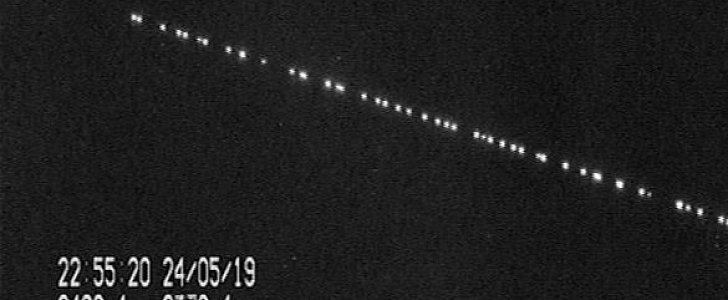The first 60 of a planned 12,000 Starlink satellites are currently in orbit, circling the globe as they are tested before more are sent up to deliver free Internet around the world. And if you’re math-savvy enough to calculate their trajectory, you might end up getting a unique view of them marching in the sky.
The image you see above is part of a video (available below) captured by astronomer Marco Langbroek in Leiden, the Netherlands, just hours after the satellites were deployed, on May 24 at 22:55 UT.
To get the images, Langbroek had to make some calculations, as there was no orbital data to help him determine where to point the camera. Using some calculations (available here), the astronomer was able to get a general idea of where the satellites will be.
So he grabbed his camera and waited, only to be rewarded (and us) with a sight we rarely get to see: a shining train of lights movingh in the sky over Europe.
“It started with two faint, flashing objects moving into the field of view,” Langbroek said on his blog. “Then, a few tens of seconds later, my jaw dropped as the "train" entered the field of view. I could not help shouting "OAAAAAH!!!!"
Langbroek was apparently not the only one to see the lights in the sky, and allegedly Starlink caused a number of UFO sightings being reported.
After these images surfaced, astronomers started expressing concerns that the shine of the satellites’ solar arrays may cause issues for the telescopes here on Earth.
Elon Musk replied to those concerns by saying he has directed SpaceX to find ways to eliminate any “material effect on discoveries in astronomy.”
Back to Langbroek, if you plan to go Starlink hunting yourself, know that the astronomer used for his observation a WATEC 902H low-light-level surveillance camera, equipped with a Canon FD 1.8/50 mm lens.
He says that in the coming days the train of satellites will pass overhead 2 or three times each night, before separating as they maneuver into their assigned positions. So if you plan to get a glimpse of them, you’d better get at it.
To get the images, Langbroek had to make some calculations, as there was no orbital data to help him determine where to point the camera. Using some calculations (available here), the astronomer was able to get a general idea of where the satellites will be.
So he grabbed his camera and waited, only to be rewarded (and us) with a sight we rarely get to see: a shining train of lights movingh in the sky over Europe.
“It started with two faint, flashing objects moving into the field of view,” Langbroek said on his blog. “Then, a few tens of seconds later, my jaw dropped as the "train" entered the field of view. I could not help shouting "OAAAAAH!!!!"
Langbroek was apparently not the only one to see the lights in the sky, and allegedly Starlink caused a number of UFO sightings being reported.
After these images surfaced, astronomers started expressing concerns that the shine of the satellites’ solar arrays may cause issues for the telescopes here on Earth.
Elon Musk replied to those concerns by saying he has directed SpaceX to find ways to eliminate any “material effect on discoveries in astronomy.”
Back to Langbroek, if you plan to go Starlink hunting yourself, know that the astronomer used for his observation a WATEC 902H low-light-level surveillance camera, equipped with a Canon FD 1.8/50 mm lens.
He says that in the coming days the train of satellites will pass overhead 2 or three times each night, before separating as they maneuver into their assigned positions. So if you plan to get a glimpse of them, you’d better get at it.

